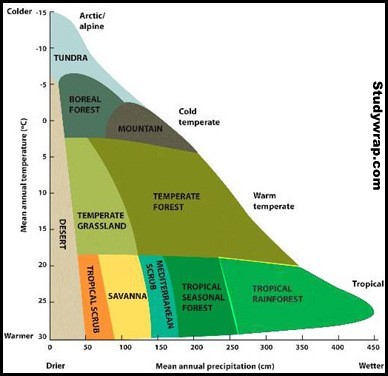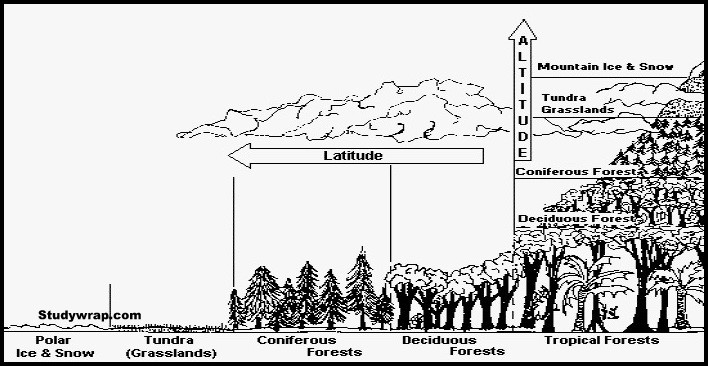Natural Vegetation of India & Factors Affecting Vegetation
Natural Vegetation of India
Table of Contents
Some Basic Terms
- Flora – refers to plants of a particular region listed as a species and considered as a group.
- Fauna – refers to the animal life, considered collectively of given environment or region.
- Vegetation – refers to the collection of plant species in a given environment or ecological setting. It is broader term than the flora which refers to species composition.
- Natural vegetation – includes that part of the plant life which grows in wild without human aid and adapts to constraints of the natural environment in size, structure and requirements. Thus cultivated crops and fruit orchards form a part of the vegetation but not natural vegetation.
- Virgin vegetation – That part of natural vegetation which has remained undisturbed by humans is referred to as virgin vegetation. It can be found in India in the inaccessible parts of the Himalayas, the Thar Desert and the Sundarbans. Elsewhere, human occupation has either transformed natural vegetation into cultivated vegetation or degraded the natural vegetation. The virgin vegetation, which is purely Indian is known as endemic or indigenous species but that which has come from outside India is termed as exotic.
- Forest – Derived from Latin word ‘Fores’. It is an area of plant community predominantly of trees and other woody vegetation, usually with a closed canopy.
Factors Influencing Natural Vegetation of India
Depending on the physical, geographical, climatic and ecological factors, there are different types of forests. Various factors which influence the type and distribution of natural vegetation –
a. Land
-
- The nature of land affects the natural vegetation directly and indirectly. E.g. the type of vegetation in the mountainous regions is different than that in the plateau and plain areas.
- The fertile land is generally devoted to agriculture, while the undulating and rough terrains are areas where grassland and woodlands develop and give shelter to a variety of wildlife.
- Topography is responsible for certain minor type’s e.g. alpine flora, tidal forests, etc.
b. Soils
-
- Different types of soils provide basis for different types of vegetation.
- The sandy soils of the desert support cactus and thorny bushes while wet, marshy, deltaic soils support mangroves and deltaic vegetation.
- The hill slopes with some depth of soil have conical trees.
- Soil is an equally determining factor in few regions. Mangrove forests, swamp forests are some of the examples where soil is the major factor.

c. Temperature and humidity
-
- Temperature and humidity are the main factors which determine the character and extent of vegetation. E.g. an area with high temperature and high humidity supports evergreen forest, while an area with high temperature and low humidity supports thorny bushes (desert).
- As the temperature falls with altitude in the Himalayan region the vegetal cover changes with altitude from tropical to sub-tropical, temperate and finally alpine.
d. Precipitation
-
- Areas of heavy rainfall have more dense vegetation as compared to other areas of less rainfall.
- See the following diagram to understand the combined effect of temperature and annual precipitation on the vegetation type of an area –
|
Annual Rainfall |
Type of Vegetation |
|
200 cm or more |
Evergreen Rain Forests |
|
100 to 200 cm |
Monsoon Deciduous Forests |
|
50 to 100 cm |
Drier Deciduous or Tropical Savanna |
|
25 to 50 cm |
Dry Thorny Scrub (Semi-arid) |
|
Below 25 cm |
Desert (Arid) |
e. Sunlight
-
- Photoperiod, also called the light duration or day length, refers to the length of the light period as compared to the darkness within a day.
- The variation in photoperiod at different places is due to the differences in latitude, altitude, season and duration of the day. Due to longer duration of sunlight, trees grow faster in summer.

f. Altitude
-
- Increasing elevation causes a distribution of vegetation similar to that of increasing latitude.
- In general, ‘altitude mimics latitude’ and there occurs a close parallel between latitudinal and altitudinal zonation of climate and thus natural vegetation too. E.g. Mount Kenya in east Africa and Mount Chimborazo in Equador have their feet on the equator but their peaks are snow covered.
- It was Alexander Von Humboldt who first recognised the relationship between vegetation and altitude.
Natural Vegetation of India
Natural Vegetation (Forests) of India has been classified in number of ways –
1. On the basis of administration
Forests have been classified into three categories –
a. Reserved Forest
-
-
-
- Forest which are under direct supervision of Government and no public entry is allowed for collection of timber or for grazing of animals.
- 53% of total forest.
-
-
b. Protected Forest
-
-
-
- Forest which looked after by Government but the local people are allowed to collect fuel wood/Timber and for grazing of animals without causing serious damage to forests.
- 29% of total forest area.
-
-
c. Unclassified Forest
-
-
-
- Forests in which there is no restriction on the cutting and grazing of cattle.
- 18 % of total forest area.
-
-
2. According to Constitution of India
a. State Forest
-
-
-
- Forest under full control of government (State/Central) and include all important forest areas.
- Constitutes 94% of total forest area.
-
-
b. Commercial Forest
-
-
-
- Forests owned and Administered by local bodies such as Municipal bodies, Town areas, District boards etc.
- Occupy about 5% of total forest cover.
-
-
c. Private Forest
-
-
-
- Forest which are under private ownership.
- About 1% forest cover.
-
-
3. Based on Composition
Based on composition and types of leaves, can be classified as –
a. Conifer Forests
-
-
-
- Temperate forests found on high altitudes.
- About 6.5 % of total forest covers.
-
-
b. Broad leaf Forests
-
-
-
- Tropical and Subtropical Monsoon Forests found in the plains, plateau and lower mountainous areas.
- About 94 % of total forest cover.
-
-
4. Based on Exploitability
Indian Forest can be classified into –
a. Exploitable Forests
-
-
-
- Contribute about 58% of total forest area.
-
-
b. Potentially Exploitable
-
-
-
- Forest which are reserved for future use.
- Constitutes about 22%.
-
-
c. Other Forests
-
-
-
- No restriction on their exploitation.
- About 20% forest fall in this category.
-
-
5. Based on Average Annual Rainfall
Indian forests have been classified into following types by L.D. Stamp –
a. Evergreen Forest
-
-
-
- Annual Average rainfall – Above 200 cm
- Found in Humid Zones.
-
-
b. Monsoon Forest
-
-
-
- Annual Average rainfall – 100 – 200 cm.
- Found in Sub-humid Zones.
-
-
c. Dry Forest
-
-
-
- Annual Average rainfall – 50 – 100 cm
- Found in Dry Zone.
-
-
d. Desert Forest
-
-
-
- Annual Average rainfall – Below 50 cm
- Found in very Dry Zones (Deserts).
-
-
Classification of Natural Vegetation of India
- Great Variation in natural vegetation is found in different parts of India which is primarily based on seasonal and annual variations in rainfall, temperature, soil, topography and various other biotic factors.
- Based on H.G. Champion classification, India’s vegetation can be divided into 5 main types and 16 sub-types as given below.

H.G. Champion’s Classification of Natural Vegetation of India
-
-
- Moist Tropical Forests
-
- Tropical Wet Evergreen
- Tropical Semi-Evergreen
- Tropical Moist Deciduous
- Littoral and Swamp
-
- Dry Tropical Forest
-
- Tropical Dry Evergreen
- Tropical Dry Deciduous
- Tropical Thorn
-
- Montane Sub-tropical Forests
-
- Sub-tropical broad leaved hill
- Sub-tropical moist hill (pine)
- Sub-tropical dry evergreen
-
- Montane Temperate Forests
-
- Montane Wet Temperate
- Himalayan Moist Temperate
- Himalayan Dry Temperate
-
- Alpine Forests
-
- Sub-Alpine
- Moist Alpine scrub
- Dry Alpine scrub
-
- Moist Tropical Forests
-
|
Forest Type in India |
% of Total Area |
|
Tropical Moist Deciduous |
37 |
|
Tropical Dry Deciduous |
28 |
|
Tropical Wet Evergreen |
8 |
|
Sub-Tropical Moist Hill |
6 |
|
Tropical Semi-Evergreen |
4 |
|
Rest below 4 % |
|
So, this was all about the introductory post of Natural vegetation of India.
In the next post (Click Here), we will Study about the classification of the natural vegetation of India.


thanks for the notes… helped me alot in my assignment
wonderful publish, very informative.
Nice post and I am impressed!